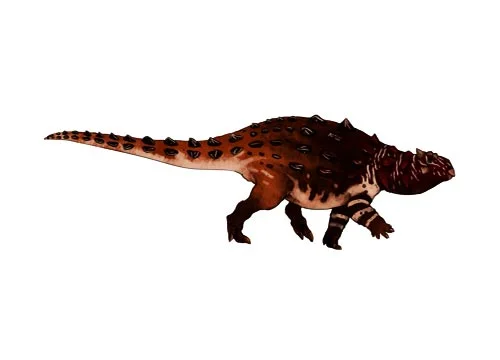Gobisaurus (Gobi lizard - after the Gobi Desert)

Go-bee-sore-us
Matthew K. Vickaryous, Anthony P. Russell, Philip J. Currie & Xi-Jin Zhao - 2001
Herbivore
Estimated 5 meters long
Armoured Dinosaur
G. domoculus (type)
Mongolia - Ulansuhai Formation, Bayan Shireh Formation in the Gobi Desert of Mongolia
Late Cretaceous, 180-72 million years ago
Gobisaurus Facts
Gobisaurus, meaning “Gobi lizard,” is a genus of herbivorous ankylosaurid dinosaur that lived during the Late Cretaceous period, around 80 to 72 million years ago. Its fossils were first discovered in the Bayan Shireh Formation in the Gobi Desert of Mongolia, and the genus was named and described by Chinese paleontologists in 2001.
Gobisaurus had a heavily-armored body, with bony plates and spikes covering its back, sides, and tail. It also had a large bony club at the end of its tail, which was likely used for defense against predators. Gobisaurus had a broad, beaked mouth for cropping and grinding plant material, and powerful hind limbs for support and locomotion.
One of the most distinctive features of Gobisaurus is its unique combination of ankylosaurid features. Its skull resembles that of the North American ankylosaurid Ankylosaurus, while its body armor is more similar to that of the Asian ankylosaurid Tarchia. This combination of features has led some paleontologists to suggest that Gobisaurus represents an intermediate form between these two ankylosaurid groups.
Based on the structure of its bones and teeth, paleontologists believe that Gobisaurus was a slow-moving, quadrupedal dinosaur that was well-adapted to its environment. Its armored body and clubbed tail would have provided effective defense against predators, while its broad, flat teeth suggest that it fed on tough, fibrous vegetation.
Gobisaurus is an important dinosaur for paleontologists because it helps to fill in gaps in our understanding of the evolution and diversity of ankylosaurid dinosaurs during the Late Cretaceous period. Its unique combination of features provides valuable insights into the ways that ankylosaurids adapted to different environments and pressures, and its importance in the ecological context of its time underscores the critical role that herbivorous dinosaurs played in shaping ancient ecosystems.
In conclusion, Gobisaurus is a fascinating dinosaur that helps us to better understand the diversity and adaptations of ankylosaurid dinosaurs during the Late Cretaceous period. Its heavily-armored body, clubbed tail, and unique combination of ankylosaurid features set it apart from other dinosaurs, and its importance in the ecological context of its time underscores the complex and varied interactions between dinosaurs and their environments. As more fossils are discovered and studied, we are likely to learn even more about this interesting and important dinosaur and its place in the evolutionary history of ankylosaurid dinosaurs.



